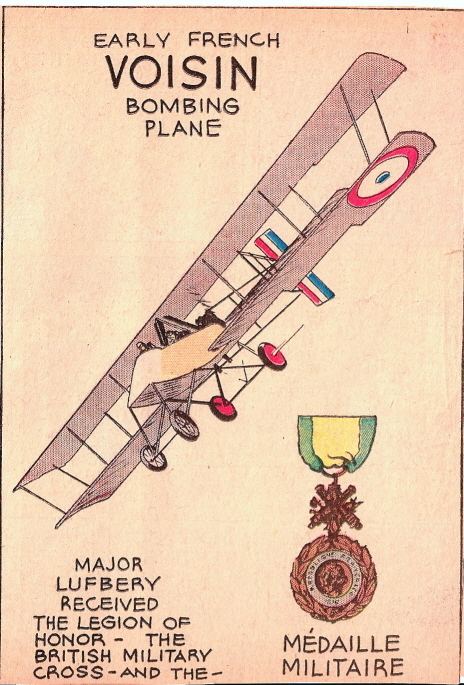Industry Aerospace Founder Gabriel Voisin Key person Gabriel Voisin | Headquarters France Founded 1906 | |
 | ||
Key people Gabriel Voisin
Maurice Colieux | ||
Gabriel voisin extrait de l histoire de l aviation de daniel costelle
Voisin was a French aircraft manufacturing company, one of the first in the world. It was established in 1906 by Gabriel Voisin and his brother Charles, and was continued by Gabriel after Charles died in an automobile accident in 1912; the full official company name then became Société Anonyme des Aéroplanes G. Voisin (English: Aeroplanes Voisin public limited company). It created Europe's first manned, heavier-than-air powered aircraft capable of a sustained (1 km), circular, controlled flight, including take-off and landing, the Voisin-Farman I. On 28 December 1909, French aviator M. Albert Kimmerling made the first manned, heavier-than-air powered flight in South Africa or even Africa in a Voisin 1907 biplane.
Contents
- Gabriel voisin extrait de l histoire de l aviation de daniel costelle
- Voisin
- Background
- Early history
- Designs of 1907 1914
- Voisin designs in World War I
- Voisin X ambulance variant
- Post World War I
- Other types of aircraft
- References
During World War I, it was a major producer of military aircraft, notably the Voisin III. After the war Gabriel Voisin abandoned the aviation industry, and set up a company to design and produce luxury automobiles, called Avions Voisin.
Voisin
Background
Gabriel Voisin had been employed by Ernest Archdeacon to work on the construction of gliders and then entered into partnership with Louis Blériot, to form the company Ateliers d' Aviation Edouard Surcouf, Blériot et Voisin in 1905. Gabriel Voisin bought out Blériot and on 5 November 1906 established the Appareils d'Aviation Les Frères Voisin with his brother Charles (English: Flying Machines of Voisin Brothers). The company, based in the Parisian suburb of Billancourt, was the first commercial aircraft factory in the world.
Early history
Like many early aircraft companies, Voisin were prepared to build machines to the designs of customers, this work supporting their own design experiments. The company's first customers were a M. Florencie, who commissioned them to build an ornithopter he had designed, and Henri Kapferer, for whom they built a pusher configuration biplane of their own design. The latter was underpowered, having a Buchet engine of only 20 hp (15 kW), and it failed to fly. However, Kapferer introduced them to Leon Delagrange, for whom they built a similar machine, powered by a 50 hp (37 kW) Antoinette engine. This was first successfully flown by Charles Voisin on 30 March 1907, achieving a straight-line flight of 60 m (200 ft). In turn Delagrange introduced them to Henri Farman, who ordered an identical aircraft. These two aircraft are often referred to by their owners' names as the Voisin-Delagrange No.1 and the Voisin-Farman No.1, and were the foundation of the company's success. On 13 January 1908 Farman used his aircraft to win the "Grand Prix de l'aviation" offered by Ernest Archdeacon and Henry Deutsch de la Meurthe for the first closed-circuit flight of over a kilometre. Since the achievements of the Wright Brothers were widely disbelieved at the time, this was seen as a major breakthrough in the conquest of the air, and brought Voisin Frères many orders for similar aircraft; around sixty were built.
Designs of 1907-1914
Voisin designs in World War I
production of the Type III increased with the outbreak of the First World War. The Voisin III was followed by improved Type LB and Type LBS, or Voisin IV and Voisin V aircraft. The larger Type LC, Voisin VII, followed in 1916, but was not a success and only a hundred were built.
Soon after the outbreak of the First World War, it became apparent that the French aviation industry could not produce aircraft in sufficient numbers to meet military requirements. Manufacturers from various other fields became aviation subcontractors, and later license-builders. The earliest such partnership was between Louis Breguet and Michelin. Gabriel Voisin was late to this field, although his designs were produced in quantity by Russian licensees. By 1918, Voisin was involved with the Voisin-Lafresnaye company, a major constructor of airframes, and the Voisin-Lefebvre company, a major builder of aircraft engines.
Following the Voisin VII came the more powerful, and more successful, Type LAP and Type LBP, known as the Voisin VIII. This was the French army's main night bomber in 1916–1917, with over one thousand built. The Voisin IX, or Type LC, was an unsuccessful design for a reconnaissance aeroplane, which lost out to the superior Salmson 2 and Breguet 14. The Voisin X, Type LAR and Type LBR, was the Voisin VIII with a more reliable Renault engine in place of the previous Peugeot design. Deliveries were much delayed, but some nine hundred were built by the end of the war.
The last significant Voisin design, the Voisin XII, was successful in trials in 1918, but with the end of the war, no production was ordered. Unlike previous Voisins, the Voisin XII was a large, twin-tractor-engined biplane night bomber, rather more elegant than previous, boxy Voisins.
Voisin X ambulance variant
In 1918, a Voisin X (No. 3500) was used to create the Voisin 'Aerochir' ('Ambulance'). The aircraft was capable of flying a surgeon, together with an operating table and support equipment, including an x-ray machine and autoclave, into the battlefield. Eight hundred pounds (360 kg) of equipment could be carried in under-wing panniers.
Post World War I
After 1918, Gabriel Voisin abandoned the aviation industry in favor of automobile construction under the brand Avions Voisin.
